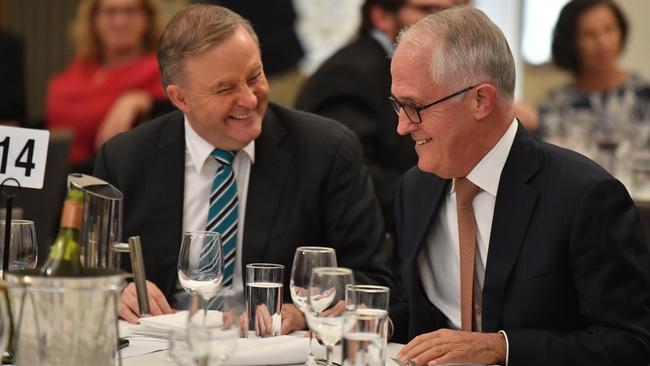Three steps Albanese needs for to secure a republic victory
The PM will need to use this term in office to lay out a detailed approach for the debate to ditch the constitutional monarchy. Turning around the dire result from 1999 requires a strategy.

I say the debate is inevitable because the death of the Queen is a defining catalyst, whether it takes a short time or a long time. It is hard to see Australians galvanising behind King Charles III as an enduring monarch. It is also hard to see us wanting to retain the monarchy when it passes on to William.
Whatever acceptance many Australians may have felt for Queen Elizabeth’s continuing rule as our head of state since 1952, it is unlikely to transfer automatically to the King, much less one prone to losing his temper with fountain pens or his entourage.
The biggest weakness likely to slow down any movement towards a republic is the design of how we do it. Those differences of opinion – for example, should a president be appointed or elected – scuttled the push for a republic when the issue went to a vote in 1999. It failed in every state, with a national result of 55 per cent against, 45 per cent for the constitutional change.
While the republican movement hasn’t had a particularly high profile since then, expect it to grow as we count down to a second referendum for change. But no one should assume success is a fait accompli. While it is inevitable there will be another high-profile debate followed by the constitutional question being put to voters, a Yes vote is not a certainty.
Becoming a republic will need to be handled delicately. For starters, management of the campaign must go mainstream, not be run by elites speaking down to the rest. That happened last time and it went down badly.
It also caused a schism in the Yes campaign: direct election advocates moved into the No camp.
As prime minister, John Howard – a passionate constitutional monarchist – managed the politics of the 1999 vote superbly, outmanoeuvring a brash Malcolm Turnbull who was leading the Yes campaign. Howard set up the referendum process to fail. By holding the constitutional convention the way he did, followed by a referendum question crafted around what Turnbull wanted, not what most Australians wanted at the time (direct election of a president), divisions defined the defeat.
Things need to be done differently this time. Which brings us to the role the Prime Minister must play. Albanese can’t pander to his left flank or to elites who enjoy the sound of their own voices. He must build support slowly and steadily for the principle of becoming a republic and the process to achieve it.
Which explains why this past week he has batted away questions about becoming a republic, labelling the issue as inappropriate to discuss during commemorations for the Queen.
Albanese also has made it clear his priority is the Indigenous voice to parliament. While I take the view governments should be able to walk and chew gum at the same time, Albanese doesn’t want that constitutional goal to be wrapped up with a republic debate. Which is why he has ruled out a referendum on a republic this parliamentary term, deciding that one constitutional referendum a term will do.
Incrementalism is defining this Prime Minister’s approach to governance. I’m not certain Albo’s strategy will succeed, but for the cautious among us the odds favour this approach over the crash-through or crash philosophy he deployed earlier in his political life.
The biggest danger is that Albanese fails to deliver the voice, killing off this government’s capacity to achieve constitutional reform before the republic gets a look-in. Or even if he succeeds with the voice, the process divides Australians, thereby making further constitutional reform more difficult.
Constitutional reform requires majority national support and a majority of states supporting the change. In other words, four out of six states must agree or referendums die. While Victoria and NSW came close the last time a republic was put to the people, the next closest state was South Australia, and to get the minimum number of states necessary Western Australia also would have had to flip. But the No case won resoundingly in WA last time, 58.5 per cent to 41.5 per cent. Opposition was even greater in Tasmania and Queensland.
A quarter of a century is a long time, and it will be longer than that before the question of a republic is put to a vote. But turning around those numbers requires a strategy.
Albanese put one in place when he appointed an assistant minister for the republic. Delaying the vote is step two in that strategy – not wanting to lunge for victory too soon, locking in defeat instead.
He will need to use this term in office to lay out a detailed approach for the debate to become a republic. For example, take the outline for how to do so to the next federal election so that in the aftermath, if he wins, there is a mandate for the process. That way he can do what Howard did in 1999 but in reverse: structure the process to favour a Yes outcome.
It requires a three-step process: a non-binding plebiscite to gauge the public’s mood, perhaps copying the same-sex marriage postal survey. The size of that Yes vote (61.6 per cent) made it impossible for opponents to block the legislation that followed.
A similarly strong Yes vote for the principle of becoming a republic would neutralise any subsequent campaign by constitutional monarchists to thwart change, shifting the discussion to step two: debate over which model we should adopt. Depending on which outcome Albanese wants, he could choose to popularise such a step (another plebiscite, for example) or use the constitutional convention process, but do so in a way that builds consensus, not divisions. Step three requires taking a single model to the people to enshrine the constitutional reform.
The path of least resistance is minimal change, whereby the president becomes a ceremonial equivalent of the governor-general, irrespective of how they are chosen. Or changing the title of the prime minister to president, and perhaps renaming the governor-general and refining the appointment process (a less likely option; imagine being a prime minister arguing you should be called a president). The political scientist in me would rather see a more extensive – and potentially radical – debate that includes wider system reform, but we don’t live in an age allowing for that.
Doing what the constitutional conventions of the 1890s did is nigh impossible today. They were radical in an era of conservatism. The irony that the social media age in which we live cries out for progressive reforms but contributes to the shelving of such reforms because it amplifies divisions is something we all need to reflect on.
Peter van Onselen is professor of politics and public policy at the University of Western Australia and Griffith University.




It remains unclear exactly how Anthony Albanese plans to manage the inevitable debate brewing over when and how Australia makes the transition to a republic. But that doesn’t mean he has no strategy.